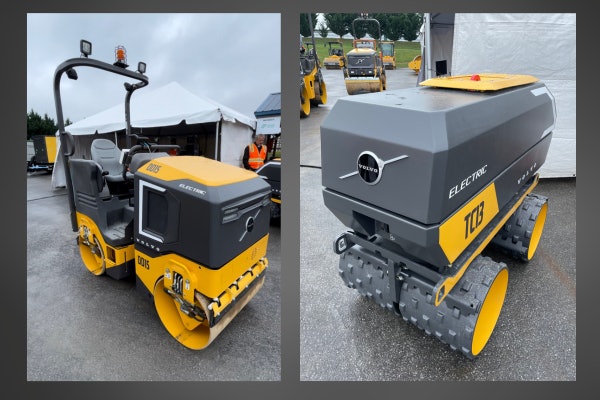Volvo CE Teases New Electric Compaction Equipment Prototypes (Video)
The DD15 Electric Asphalt Compactor and TC13 Trench Compactor are meant to complement Volvo's other electric machines and will...

Volvo CE is expanding its lineup of electric compaction equipment, but the new models aren’t ready for jobsites just yet.
The manufacturer teased prototypes of the DD15 Electric double-drum asphalt compactor and TC13 Electric trench compactor at its recent Volvo Days North America event in Shippensburg, Pennsylvania.
Volvo CE entered the electric asphalt equipment market in January 2023 with the introduction of the 2.5-ton DD25 Electric asphalt compactor. It does not currently offer any trench compactors, and the electric model will mark its return to the segment since acquiring Ingersoll Rand’s road development equipment division in 2007.
DD15 Electric
The DD15 will have similar features but in a smaller 1.5-ton package, ideal for rental customers, driveways and other small asphalt jobs, say Volvo CE product manager Justin Zupanc.
No formal runtime numbers are being shared yet, but Zupanc expects that with typical light usage, the battery should offer “a few days of operation” on the jobsite. The battery can be recharged in about 8 hours with a Level 1 charger, or two to three hours with Level 2 charging.
The controls on the operator station are also still in the prototype stage.
Volvo CE is currently collecting feedback on the machine and expects an official launch to occur sometime before ConExpo 2026. To get a walkaround of the preliminary model, check out the video below.
Since no specs for the electric model were shared, we took a look at some of the features on the conventional model for comparison.
The 3,372-pound diesel-powered DD15 comes in a 35.4-inch narrow drum or 39.4-inch wide drum version with 66.7 Hz frequency. The narrow drum model features front-drum vibration, double-drum vibration or static-only mode, while the wide drum version offers double-drum vibration or static mode.
Water flows only when the compactor is moving in automatic mode. The standard pressurized spray system distributes water evenly across each drum.
The high curb and minimal side clearances make maneuvering around obstacles easier. The operator platform is isolated from the vibratory drum for enhanced safety and comfort.
Additional standard safety features include ROPS, a grab handle on both sides of compactor, spring-applied, hydraulically released parking brake, an emergency stop switch, a continuous seatbelt alarm, seat shut down switch and propulsion control with neutral start.
Daily maintenance points are accessible at ground level.
TC13 Electric Trench Compactor
Ingersoll Rand last offered the 1.3-ton TC-13 Trench Compactor in 2004, and now Volvo CE is reimagining it with an electric motor.
“The battery itself is not really novel,” says Zupanc. “But what makes it unique is two-way charging.”
The unit has 120-volt and 240-volt AC outlets in the rear of the machine and is capable of charging anything that uses AC voltage, from laptops to battery-powered hand tools.
Zupanc says Volvo CE will not be producing a diesel-powered version of the new TC13, saying it is meant to pair with its other electric machines.
“There’s an opportunity for battery electric to not only provide a product that works but fits in with other compact products that are battery electric. You’re probably going to see this type of product on the job with an ECR25 or L25…so really just that full product architecture that fits together nicely.”
No specs on speed or compaction forces were available yet. The TC13 Electric will also be released sometime before ConExpo 2026.
Taking a look at the last published specs on the diesel-powered Ingersoll-Rand TC-13, the unit offered 17,100 pounds of centrifugal force, 2,500 vibrations per minute and a nominal amplitude of .056 inches. Standard drum width was 33.5 inches. An optional 24-inch narrow width unit was also offered.
The compactor was operated using a hand-held remote control. Auxiliary controls were mounted on the rear for tramming.

 machineryasia
machineryasia 




![[Job Story] Two Liebherr Cranes Building Alaska’s Longest Single-Span Bridge](https://www.heavyquipmag.com/wp-content/uploads/2026/01/liebherr-lr1300.1sx_2_300dpi.jpg)



